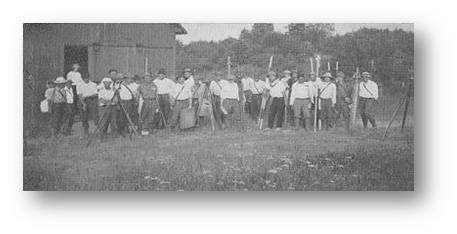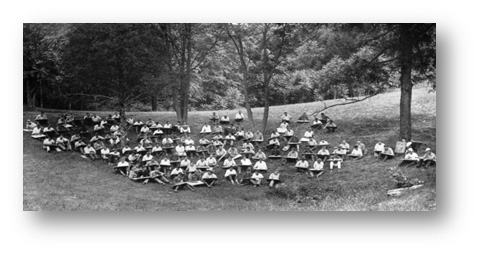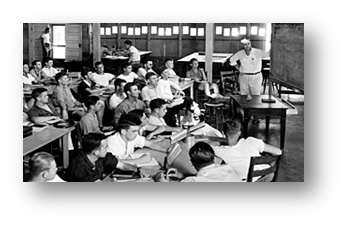Ross Summer Surveying Camp at Purdue

In the early years of Civil Engineering at Purdue, students toting tripods and transits was a familiar site on campus. They learned the art of surveying on the land where the Memorial Union building now stands or over rolling terrain near the West Lafayette Water Tank on Salisbury Street.
Eventually, to open class time during the school year, a summer surveying camp was instituted that took students away from campus for up to 8 weeks to learn surveying among picturesque, wooded settings.
From 1914 to 1927, Purdue Civil Engineering students attended summer surveying camps directed by C. C. Albright at various scenic locations: the State Forest Preserve near Henryville, Indiana, Pentwater and Glen Lake, Michigan and McCormick State Park near Spencer, Indiana. Then, the idea of a permanent camp was tossed around, and Purdue trustee and benefactor, David E. Ross entered the picture.

In 1926, Ross purchased 140 acres of farmland adjacent to his summer home, "The Hills," for use as a permanent surveying camp. The land lay 12 miles southwest of campus along the Wabash River. He gave the land to the University, and it was named the "Ross Summer Surveying Camp." During the next two summers, freshmen were enlisted to construct buildings and infrastructure at Ross Camp. The students spent half of their day learning surveying and the other half constructing barracks, a kitchen and more, earning 50-cents an hour.
Professor of Topographical Engineering, G. E. Lommel, was camp director from 1929 until his retirement in 1958. Each morning at 6:30, he met David Ross on the South River Road for a talk about the progress. Students constructed an access road, a main building and a garage for storage, a gravel pit, and a septic tank and sewers. Ross Camp, with its wide-open spaces and forest glens dotted with structures and life, was described as resembling a picturesque village in the hills of New England.
The Ross Civil Engineering Camp was formally dedicated on October 13, 1928. After a rough trip by army truck from West Lafayette, about 300 Civil students attended the ceremonies. Improvements were made yearly. During the summer of 1929, Purdue President Edward C. Elliott and David Ross visited the camp on a very hot day. Elliott asked the students if they cooled off by swimming in the river and was told that the staff prohibited swimming in the Wabash. It was then that David Ross donated the materials needed for the students to construct a swimming pool. Ten years later in 1939, camp buildings were first wired for electricity, ending an era of Coleman lanterns.

In his autobiography, Leonard Hasse, a 1963 alumnus, describes a day at Ross Summer Surveying Camp in 1960, the final year of the camp's operation: "We dressed lightly - me in a tan pith helmet or fatigue cap, fatigue pants, combat boots, web belt, and canteen of water. We started the day by raising the flag and then having breakfast. We would get our assignments then go out in the field to do our surveying or leveling, taking notes of our readings. We would break for lunch then go back out in the field until the end of the day...We would transcribe our notes in the evening, do the plotting, and write our reports. The terrain at Ross Camp was very rugged. We learned to use all current surveying instruments...I normally went shirtless and finished the camp with a very dark tan and a beard."
In August 1960, the last of the summer surveyors completed their rounds and the gates to Ross Camp were closed. The figure of the rough-and-ready student, dressed in field garb, shouldering a transit, receded into the past. Today, what was the Ross Summer Surveying Camp and the home of David Ross is part of a county park called Ross Hills Park. The legacy of the Ross Summer Surveying Camp that ran for 30 years is the thousands of Purdue Civil Engineering students who learned both the science and the art of surveying, their dedicated instructors and the camp's generous benefactor, David E. Ross.

